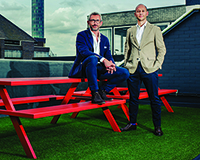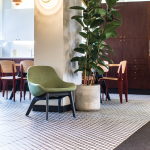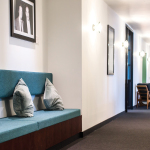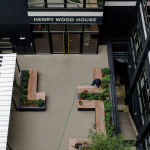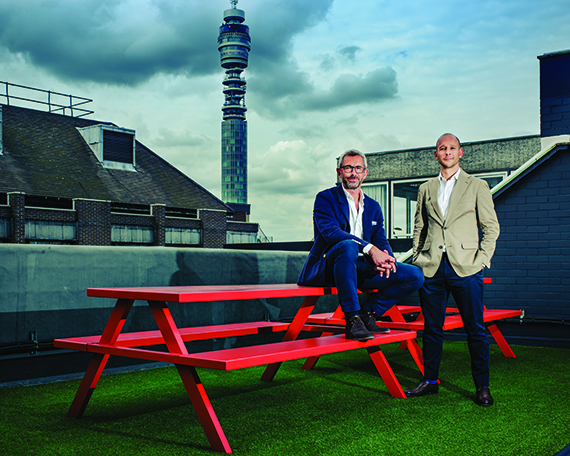
If there was ever an example of how a spot of beach-based hedonism can work wonders for your career, the chance meeting between Charlie Green and Olly Olsen would be up there with the best of them.
It was 1993 when the pair crossed paths for the first time at a party in Thailand – a meeting so crucial it would later shape their professional lives. A meeting so crucial that Olsen has no recollection of it. “It’s true. I can’t recall the first time I met Charlie,” he laughs. “But come on… it was on a beach in Thailand,” he smiles with a self-explanatory shrug.
But a meeting with a 50% recollection rate is better than no meeting at all and once Olsen was in a better frame of mind the duo became friends and, a decade later, business partners. One of the early disruptors in the workplace sector, they launched The Office Group in 2003 to deliver their answer to serviced offices. Now the business is valued at £500m, with 29 buildings across 900,000 sq ft – the majority of which is in London – and more than 12,000 users.
The pair have been working tirelessly on perfecting their formula for the past 11 years. Today the sector is exploding across the globe in a way that not even the most ambitious traditional office disruptor would have been able to predict five years ago. A tribe of start-ups, entrepreneurs, freelancers and tech-enabled mobile workers now flock to exactly the type of space – and service – The Office Group provides.
The company operates out of some of London’s most high profile landmarks including The Shard at London Bridge, SE1, and is preparing to take 20,000 sq ft in Derwent London’s hotly anticipated White Collar Factory, EC1, when it opens next summer. And Olsen and Green are gearing up make sure they keep up with the competition as the sector continues to mushroom. “We are aiming to buy and lease an additional 2m sq ft over the next two years,” says Green. “We think this sector will only grow and that it will accelerate well beyond where it is now. Demand will only increase and there is no reason we can’t become one of the UK’s biggest property developers.”
On a tour of their Henry Wood House space in Oxford Circus, W1, the pair reveal what they have set their sights on next and how they plan to stay ahead of the competition.
Competition time
Because that’s the thing about workspace that offers something different to traditional office buildings. As the sector balloons, so does the competition. And the other players are not exactly small fry. WeWork – the $10bn (£6.6bn) co-working start-up launched in New York in 2010 – now runs 57 locations in 17 cities and launched in Devonshire Square, EC2, earlier this year.
Despite such aggressively ambitious new rivals there have been no signs of a dip in tenant numbers for The Office Group – Henry Wood House opened in February 2015 and was fully let within eight weeks. But then it offers something a bit different. Office Group’s buildings are not all about co-working, in fact, it makes up a very small proportion of the business – just 8% – and only 14% of users fall into the co-working category. “We don’t believe the traditional co-working concept to be a viable business model in isolation,” says Green. “It works where it’s part of a more comprehensive offering. We provide open, shared office space as part of our overall product, but our core income is private offices.”
Indeed, most Office Group tenants – which have included Facebook, Dropbox and Mumsnet – are not just dropping in but are signing up to private offices on formal leases with an average length of around 36 months. “For most people who take up space in one of our buildings it’s not our space, it’s their space,” says Olsen.
This may be the case. But it does not stop The Office Group from putting its own stamp on every building it takes. And the company’s dedication to design and ambience is one of its major selling points.
Design for working
“Design is one of the key differentiators from our competition, both in how the buildings look and how they work and flow,” says Olsen. “Each building is designed differently and there is no generic, formula approach.”
The 76,000 sq ft Henry Wood House is a case in point. Filled with one-off artwork and pieces designed by tenants through to the inside of the lifts, which have been plastered with wallpaper designed by artist Lizzie Allen, it has a distinct personality, befitting its position next door to the iconic BBC Broadcasting House. The communal areas and coffee zones are suitably laid-back and creative. The music in some of the co-working areas has been specially curated to encourage productivity, and the onsite gym room (complete with a former cage fighter for a personal trainer) and the strict quiet zone library gives the building something extra.
And, in an Office Group first, the Oxford Street building also has a rentable bedroom space. The Penthouse comes with a double sofa bed, shower and kitchen and two bathrobes. Is there a chance this little add-on could be misunderstood or, at the very least, misused?
“What on earth do you mean?” exclaims Green, feigning shock. “We hadn’t thought of it that way,” he concedes once the laughter has died down. “It will be monitored though, obviously, as it will be aimed at people who need to stay over in the centre of London.”
London expansion
As to future plans, the answer – while not definitive – is largely a focus on the capital. “London continues to be our target for growth,” says Green. “We’re responding to what people want from their space and we believe the demand, and therefore scope for growth, is significant. Bigger buildings will allow us to be more generous with the range of facilities and services, so in the right locations we’re looking at 50,000 to 150,000 sq ft.”
He adds: “There is nowhere we wouldn’t look,” saying only that the most desirable target areas will shift based on where London’s next transport hubs emerge. The pair will not be drawn on whether they are looking as far out and into the future as Silvertown Quays, where there are high-profile plans to convert the Millennium Mills building into a start-up hub. But the announcement this summer that they will be taking a 20-year lease on the first to third floors of the White Collar Factory signals increasingly ambitious expansion plans.
As for the spaces themselves, in such fast-moving times flexibility is key. “The inability to predict space needs beyond around 12 months means that companies have to incorporate that flexibility into their business plans,” says Olsen. “We’ve seen the average size of office in our portfolio increase from five people three years ago to 15 today. We anticipate this growing, showing that our product is not just for the smaller businesses but is very much needed by more established businesses as well.”
Established enough to help achieve that goal of 2m sq ft in London in the next two years? And become one of the biggest developers in the UK?
Who knows? But even if they fall short of their more ambitious plans, after 11 years of all-important groundwork The Office Group looks set to ride the crest of the serviced office wave. Pretty good going for a partnership that came about after a chance meeting that only one of them was sober enough to remember.
How did the Office Group fare on Estates Gazette’s list of the top 50 collaborators in property? Click here to find out







